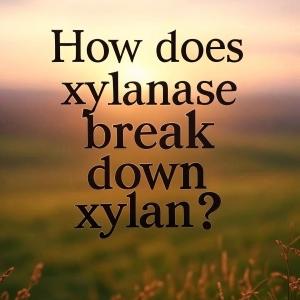How does xylanase break down xylan?

Xylanase is a natural enzyme that specializes in breaking down xylan, which is a major part of plant cell walls. You’ll find xylan in things like cereal grains, corn husks, and even hardwoods. Since humans and many animals can’t digest xylan on their own, xylanase steps in to help convert it into simpler sugars that are easier to work with and absorb.
How Does Xylanase Break Down Xylan?
Xylan is made up of long chains of xylose sugar molecules, and these chains are tough for most digestive systems to handle. Xylanase works by cutting those chains apart. It breaks the bonds between the xylose units, turning the long xylan structure into smaller pieces like xylo-oligosaccharides and free xylose. These smaller molecules can be digested or used by beneficial gut bacteria, depending on where the enzyme is working.
The reaction usually happens in a water-based environment. Xylanase targets the β-1,4-glycosidic linkages—the technical term for the bonds holding the xylose units together. Once those are broken, the structure of the xylan falls apart, making it easier to extract nutrients or improve texture in food products.
What Does Xylanase Break Down?
Xylanase specifically breaks down xylan, which is part of a group of fibers called hemicelluloses. These are found in the cell walls of most plants, especially in grains like wheat, rye, and barley. In practical terms, xylanase helps process ingredients that come from plants—whether that’s in bread dough, animal feed, or paper pulp. It doesn’t touch starch, cellulose, or proteins; it’s all about the xylan.
Why It Matters in Everyday Use
In baking, xylanase improves dough quality and bread volume. In animal feed, it makes grain-based diets more digestible. In the paper industry, it helps reduce chemical use by breaking down non-cellulose components of wood. Even in biofuels, xylanase helps release sugars from plant waste so they can be turned into energy. All of this starts with its ability to break down one tough fiber: xylan.
What Makes Xylanase Different from Other Enzymes?
Enzymes like amylase break down starch, and protease breaks down protein. Xylanase is unique because it targets a fiber that most enzymes ignore. Its job is very specific, but that’s what makes it valuable. It’s designed to tackle a complex sugar structure that’s usually resistant to digestion or processing, opening the door to better performance in everything from food to fuel.


